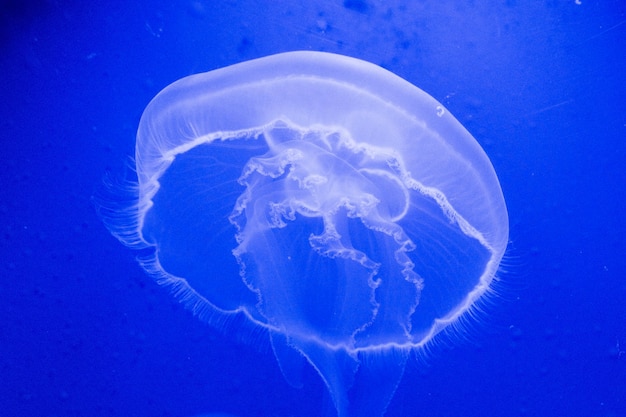Moon Jellyfish Facts

Moon jellyfish, also known as Aurelia aurita, are delicate and translucent creatures.
Moon jellyfish have a distinctive bell-shaped body with short tentacles.
These beautiful creatures can be found in oceans and seas worldwide.
Moon jellyfish can be found in both warm and cold waters.
They are typically found in coastal areas and are often seen near the surface of the water.
Moon jellyfish are not strong swimmers and rely on ocean currents for movement.
Despite their fragile appearance, moon jellyfish are resilient and have a unique ability to regenerate damaged body parts.
Moon jellyfish have a unique feeding habit – they capture plankton and small fish using their long and sticky tentacles.
These tentacles contain specialized cells called nematocysts, which can deliver a mild sting to their prey.
Moon jellyfish are mainly nocturnal, preferring to feed during the night and resting during the day.
They are often seen in large groups known as blooms or swarms.
Moon jellyfish are considered an indicator species, meaning their presence or absence can indicate the health of an ecosystem.
Moon jellyfish have a lifespan of approximately one year.
They have a simple nervous system and do not possess a brain or a central nervous system.
Moon jellyfish have a mesmerizing bioluminescent glow, which adds to their ethereal beauty.
Moon jellyfish are sometimes kept in aquariums due to their captivating appearance.
Moon Jellyfish Facts part 2
Moon jellyfish have a unique reproductive cycle that involves both sexual and asexual reproduction.
They release their eggs and sperm into the water, where fertilization takes place externally.
Once the fertilized egg develops into a planula larva, it settles on a suitable substrate and transforms into a polyp.
The polyp stage of the moon jellyfish life cycle can last for several months or even years.
When conditions are optimal, the polyp undergoes a process of asexual reproduction called budding, where it produces tiny medusae (baby jellyfish).
Moon jellyfish have a mesmerizing pulsing movement that propels them through the water.
They are capable of contracting and relaxing their bell-shaped bodies, allowing them to move with grace and ease.
Moon jellyfish are found at various depths in the ocean, ranging from the surface to several hundred meters.
They are considered a relatively harmless species of jellyfish, with their mild sting usually causing only minor irritation to humans.
The mouth of a moon jellyfish is located on the underside of its body and doubles as an anus.
Moon jellyfish have a unique adaptation known as a statolith, which helps them maintain balance and orientation in the water.
Moon jellyfish are highly sensitive to changes in temperature, salinity, and pollution, making them indicators of environmental changes.
They are an important food source for several marine organisms, including sea turtles and certain species of fish.
Moon jellyfish have a mesmerizing movement that can be likened to a slow, graceful dance in the water.
Their translucent bodies allow sunlight to pass through, creating a stunning effect when illuminated from above.
Moon jellyfish have a gelatinous texture, giving them a delicate and fragile appearance.
They are often found in estuaries and coastal lagoons, where the water is partially saline.
Moon jellyfish lack a respiratory system and rely on simple diffusion to exchange gases with the water.
The tentacles of a moon jellyfish can grow up to several meters long, depending on the size and age of the individual.
Moon jellyfish can be found in various colors, ranging from pale white to shades of pink, blue, and purple.
They have a unique mesoglea, which gives them buoyancy and allows them to float effortlessly in the water.
Moon jellyfish are not aggressive and rarely pose a threat to humans, making them a popular species for snorkeling and diving enthusiasts.
They are often used in scientific research to study various aspects of marine biology, including evolutionary development and reproduction.
Moon jellyfish have an average size of 25-40 centimeters in diameter, although there have been reports of larger specimens reaching up to 60 centimeters.
Their population levels can fluctuate significantly, depending on various factors such as food availability and oceanic conditions.
Moon jellyfish can undergo a process called ecdysis, where they shed their old, damaged tissues and replace them with new ones.
They possess a unique defense mechanism where they can contract their tentacles when threatened, reducing their vulnerability to predation.
Moon jellyfish have a calming effect on people, with their gentle movements and soothing appearance often used in meditation practices.
Exploring the world of moon jellyfish can offer a glimpse into the wonders of the ocean and the delicate balance of marine ecosystems.